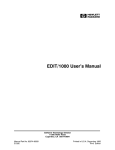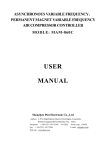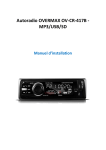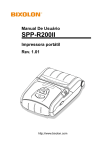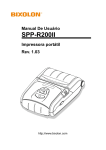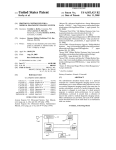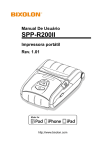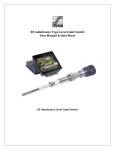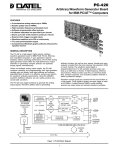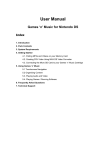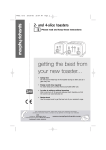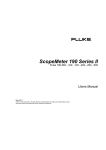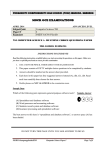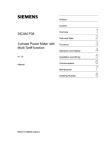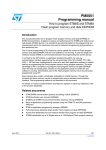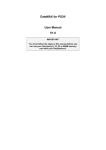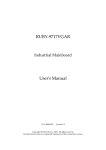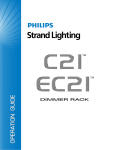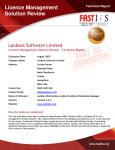Download spec sheet
Transcript
Last Time Buy Notice – Board Products November 7, 2003 Effective immediately, DATEL, Inc. will be phasing out its line of board-level data acquisition products. We will accept last time buy orders until February 28, 2004. Final shipments must be accepted by June 31, 2004. In addition, all repairs and technical support must be concluded by September 30, 2004. Please contact DATEL Sales as soon as practical to schedule your order. If this Notice is received by Purchasing, Materiel or Procurement personnel, we strongly encourage you to forward this to your Engineering, Administrative and Program colleagues as soon as practical. Models to be Discontinued - Essentially all DATEL board-level data acquisition products, all board-level accessories and all board software are covered in this Notice. This includes: All ST-xxx model numbers (Multibus I boards, example ST-711) All PC-xxx model numbers (ISA bus boards, example PC-414) All DVME-xxx model numbers (VME bus boards, example DVME-628) All CPCI-xxx model numbers (Compact PCI bus boards, example CPCI-511) All PCI-xxx model numbers (PCI bus boards, example PCI-416) Please note that many older ST-xxx, DVME-xxx and PC-xxx boards are already on very limited availability due to component obsolescence and other manufacturing issues. Last Time Orders - Customers should contact the DATEL Sales Dept. (Mansfield, MA, USA) directly to place orders and negotiate delivery schedules. Some products may require minimum order quantities and/or extended delivery. This varies over time so it is difficult to give an exact list of such products. To assure supply, we encourage customers to accept deliveries as soon as practical. As time passes, customers risk non-availability of an increasing number of products. After the customer accepts final order acknowledgement, all orders placed will be firm and noncancellable. Warranty - DATEL’s standard warranty terms apply except the warranty period. As the date of last shipments approach, warranty support and repairs will terminate on September 30, 2004. Customers must immediately perform a functional inspection on any shipments near this date. DATEL will have no technical or repair facilities after this date. Technical Support - Since some DATEL engineering resources have already been reallocated, support and repairs are currently limited and more will be withdrawn over time. We encourage users to get all support issues settled as soon as practical. Replacement Products - DATEL is not aware of any competitive manufactured products which are exact replacements for these products. However, there are numerous items with similar functions. These will require re-integration with your application. Manufacturing Rights - DATEL is not offering manufacturing rights on these products. The difficulty here is the complexity of technical support to fully transfer all comprehensive details of manufacturing (including test fixturing, component specifications and device programming). Most of these products would require considerable re-engineering by the user to resume production outside DATEL. Nor will we retain spare parts after September 30, 2004. Volume users should contact DATEL to discuss their needs. ******* As very large volume component users ourselves who are subject to frequent component obsolescence issues, DATEL sincerely regrets any inconvenience this Notice may cause our customers. 11 Cabot Blvd, Mansfield, MA, 02048 USA, website: www.datel.com Phone: 508-339-3000 FAX: 508-339-6356 E-mail: [email protected] PCI-417 Series ® ® INNOVATION and EXCELLENCE Advanced Performance Analog Boards For Desktop PCI Bus Computers FEATURES • Simultaneous A/D sampling with no skew delays • Collects gigabytes of non-stop A/D samples • Analog input options up to 40 MHz • Up to 512 Kb on-board FIFO A/D memory • For radar, DSP, FFT and signal processing • PCI bus master DMA burst block transfers • Two simultaneous streaming D/A waveform outputs • Windows® 98/NT/ME/2K/XP device driver, DLL Visual C++ software and ActiveX controls • Rich program library source code for developers In a departure from standard A/D system architectures, the PCI-417 family is a high performance fully streaming A/D-D/A board series with advanced multichannel 32-bit ADW analog input modules and up to half a megabyte of FIFO (first-in, first-out) on-board A/D sample memory. The wideband analog options cover 12 to 16-bit A/D resolution, one to 32 simultaneous channels and up to 40 MHz A/D sampling. Both the carrier board and the analog section uitlize very high density programmable logic for efficient integration with the PCI bus. The entire system is intended for continuous, non-stop rapid acquisition of analog waveforms to host memory, network link or disk array. By properly using the on-board PCI bus master DMA controller, the PCI-417 will collect hundreds of megabytes of high speed A/D data to host memory without sample loss. Using a fast host disk (especially a RAID system) will collect many gigabytes of data. The PCI-417 is ideal as a wideband “front end” for Digital Signal Processing, FFT (Fast Fourier Transform) and advanced signal analysis applications of all kinds. Modular 32-bit Pluggable Analog Module The A/D section is contained in a pluggable ADW series analog module. With some limitations, any PCI-417 may be converted to another version simply by swapping ADW modules. The ADW architecture features a full 32-bit wide bidirectional local interface to the on-board FIFO memory and PCI bus interface. Each A/D option includes separate A/D converters for each channel and a very efficient method of combining multiple channels into long frames of data. A/D clocking may use an on-board programmable Frequency Synthesizer (up to 40 MHz), local crystal oscillator with programmable binary divider, external user-supplied clocking or from a custom-frequency on-board oscillator module. Frame triggering is either from an internal crystal-stabilized timer or from external analog or digital triggering. The analog trigger uses a threshold comparator formed from D/A channel 0. Each frame is selected by an on-board 24-bit (16 million sample) programmable Sample Counter which terminates the frame when the sample count is reached. Triggering may occur once per frame (with automatic sample count reload) or may run indefinitely (“forever”) to collect unbroken data streams of any size. A special pretriggering mode collects data before and after an external trigger starts the sample count down. Streaming Analog Outputs Two 16-bit D/A channels are included in the output section which is fully streaming by virtue of an on-board FIFO memory dedicated solely to the D/A’s. The PCI-417 emphasizes high speed simultaneous multi-channel sampling and low system noise for waveform I/O applications. The D/A converters sample together in parallel, using the upper and lower halves of a 32-bit word. Each D/A is fed by a 8192 sample FIFO memory (4Kx32) so that the host CPU does not require constant servicing of the output section. The D/A’s may be programmed directly (FIFO is bypassed) if preferred. Each D/A features both 50-Ohm current and voltage outputs. For discrete I/O and external device control, a programmable 24-bit buffered digital parallel I/O port is included with the data direction selectable in bytes. A spare programmable 16-bit timer with 10 MHz crystal timebase is also available for any purpose and may be configured as a D/A FIFO sample clock. Software Each board is supplied with a Windows software system which sets up the board, starts A/D or D/A sampling, saves data to memory or disk and displays signal waveforms. This software is available in source code as a comprehensive programming example. The PCI-417 is offered with an optional full Visual “C++” DLL programmer’s library (model PC-CDROMS) for Windows 98SE, NT, ME, XP and Windows 2000. Multiple boards may be operated simultaneously in one computer. The PCI-417 family includes detailed register-level documentation for full support of programmers. The product is furnished on a single long PCI-bus board which is compatible with desktop computers. DATEL is a DATEL, Inc. trademark. LabVIEW is a National Instruments trademark. Pentium is an Intel Corp. trademark. Windows, ActiveX and MS-DOS are Microsoft Corp trademarks. StarDAS is a Hyperception trademark. DATEL, Inc., Mansfield, MA 02048 (USA) • Tel: (508)339-3000, (800)233-2765 Fax: (508)339-6356 • Email: [email protected] • Internet: www.datel.com ® WRFF Analog Inputs Reset Synchronous FIFO A/D Memory 32 Pluggable ADW A/D Module Family Half Full Clock AWG 4 SSH ADW Control Bus Type A/D Channel Address U19 C Clock Select Multiplexer 1 2 3,7 10 20 40 MHz ÷2 ÷2 Freq. Synth. A/D Clock 32 1 Internal Trigger 32 SG15 SG16 40 MHz External A/D Clock In J6 50Ω Internal Trigger C Registers & Control SG1 Xcvr EOS Clk1 PLL Code 14 20-40 MHz 10 MHz D/A FIFO Memory 24 0 SG2 DAC 0 External Trigger In P5-30 50Ω CLKAWG 16 SG11 15-0 A/D Trigger Select A/D Sample Counter 16-bit Divider External D/A Clock In J5, P5-4 31-16 A External Clock SG13 DAC 1 DAC 0 Vout B 4 D/A Clock Control Marker* In P5-14 Channel 0 J4 J3 External Digital Trigger External Analog Trigger In 2 40 MHz External WR PTDAT 5 User OSC 5 ADW Control(3) 8 Channel 1 J1 J2 ® P7 External A/D Clock In 20-40 MHz D/A Direct and Buffered Outputs Empty External Trigger In* 0 6 Analog Trigger In P5-12 Full Clk2 Timer 82C54 P5 24-bit Digital Input/ Output Digital I/O 82C55 32 LED Lamp 32-bit Local Bus Filters Boot Strap NVRAM PCI Bus Controller S5933 Interrupt A/D Pass-Thru State Machine Local DC Power –15V +15V +12V P2 –12V +5V ±15 V DC/DC Converter M1 (Optional) Grounds PCI-417 Block Diagram PCI-417 PCI Bus ® PCI-417 SPECIFICATIONS (Typical at +25°C, dynamic conditions, unless noted) Analog Trigger Hysteresis ANALOG INPUTS Pluggable Analog Input Module The trigger will not retrigger until the reference signal has retraced ~50 mV from its initial trigger slope Compatible with all current 32-bit “ADW” series analog modules. See the Analog Input Characteristics tables below. Number of D/A Channels Two channels, 16-bit resolution Channel Addressing <Note 13> 5-bit address code, non-incrementing D/A Data Access Data Transfer Two samples (32 bits) are always transferred with each sample clock to the A/D FIFO memory The 2 D/A’s are programmed in a single 32-bit wide register so that they update simultaneously D/A Voltage Output Range ±2.5V @ 5 mA max Data Format Each 32-bit transfer sends either two sequential single channel samples (ADW-12M in single channel mode) or two simultaneous adjacent channels (all other ADW modules) Voltage Output Settling Time 1 µSec max, full scale, –3 dB bandwidth <Note 6> D/A Voltage Output Coding Offset binary bipolar D/A Direct Current Outputs 1000 ohms, 20 mA max, 0 to –1 V <Note 14> ANALOG OUTPUTS ADW to FIFO Transfer Rate 40 MHz x 32 bits min <Note 5> A/D Module Identification A 4-bit code identifies the installed analog module Current Output Settling Time 100 nS <Note 4> D/A Current Output Coding Inverted straight binary unipolar On-board A/D FIFO Memory Up to 256K samples (128K x 32) <Note 3> On-board D/A FIFO Memory 8192 samples (4K x 36) <Note 4> PCI Bus Access to D/A FIFO By I/O register transfer only PCI Bus Access to A/D FIFO Either by PCI Bus Master DMA or by I/O register block transfer D/A Clock Sources A/D Clock Sources On-board 40 MHz crystal divider, on-board frequency synthesizer, external A/D clock or user-installed on-board oscillator Selectable from the A/D clock or external. The external clock may be connected to the on-board spare 82C54 rate generator by jumpering across a header connector. A/D Timebase Divider Programmable 16-bit binary divider Data Bus Size 32 bits, I/O mapped External A/D Clock Continuity The external A/D clock may be non-continuous with no loss of samples <Note 2> PCI Bus Controller AMCC S5933 DMA Bus Controller A/D Sample Counter 24-bit counter, One to 16,777,216 sample capacity, 20 MHz max.. The sample counter may also be disabled. <Note 8> Included with S5933. Acts as temporary PCI bus master. 224 DWORD block count. PCI Standards Compliance Desktop PCI Interrupt to PCI Bus Selectable INTA (std.), INTB, INTC, or INTD. Non-DMA PCI Bus Interrupts A single interrupt may be OR’ed from the A/D FIFO half full, D/A FIFO less than half full or A/D sample count=0. Host software polls to determine which interrupt occurred. DMA PCI Bus Interrupt Occurs when DMA Transfer Count=0 (included with PCI controller) PCI BUS INTERFACE A/D TRIGGER Trigger Sources Programmable internal, external digital or external analog. The analog trigger requires dedication of D/A channel 0 as a threshold reference voltage Pretrigger Operation The Sample Counter may be disabled or may start a delayed count down at an external trigger Pre/Trigger Lock-out MISCELLANEOUS Once a frame is started, additional triggers or pretriggers are ignored <Note 9> Master-Slave Triggering/Clocking <Note 11> Analog Trigger Input Range ±10 Volts Analog Trigger Polarity A positive-going signal compared to the programmable D/A reference level causes a trigger when selected Analog Trigger Response Triggering occurs within 2 microseconds of crossing the D/A threshold, assuming that the input signal is within the linear operating range 3 External Marker* Input Bit 31 uniquely tags a single A/D data sample pair from an external falling edge logic input for as long as the user holds the marker low TRUE <Note 1> Spare Timer/Counter One 16-bit timer/counter section of the 82C54 is available for any function. All 3 controls (clock, gate and output) are available on the header connector. 10 MHz max. Registers (all are 32-bit access) Command, Status, Sample Count, A/D FIFO Reset, Timebase Divider, Phase Lock Loop, D/A Data, Status 2, ADW Address, D/A FIFO Reset, ADW Data, 82C54 Timers, 82C55 Parallel I/O. Several registers are read/write for diagnostics. ® ® ® PCI-417 Digital Input/Output 24 lines, 82C55 controller, internal header connector, 1.6 mA max output, 2 MHz. max. On-board LED Lamp This lamp is fully programmable by the user for diagnostics <Note 10> A/D Input Connector On ADW module, normally DB-25 female or SMA miniature coaxial. <Note 15> On-board Internal Header Connector 50 pins for D/A output, digital I/O, External Connector D/A Clk In, Marker in, Analog Trig. In, A/D Clk Out, External A/D Clk In, ±12V power. SMB Coax Connectors D/A Direct outputs (4), Extrn A/D Clk In, External D/A Clk In. The SMB connectors and cabling do not interfere with an adjacent board. PCI Bus Power Required +5 Vdc at 4 Amps max., supplied by PCI bus. ±12 Vdc (1A max.) usage is required if no DC/DC converter is installed (default). <Note 12> DC/DC Power Converter (optional) Supplies ±15 Vdc analog power. The PCI bus ±12Vdc power will normally be used instead. Board Outline Dimensions 4.187"W × 12.313"L × 0.75"H Slot Width The combined ADW carrier board does not interefere with insertion of an adjacent full length PCI board. Operating Temperature Range 0 to +60°C. Forced cooling required. No thermal shock. Storage Temperature Range –25 to +85°C Altitude 0 to 10,000 feet Relative Humidity 10% to 95%, non-condensing Fabrication Double-sided, high density, multilayer glass epoxy, surface mount printed circuit board. CAUTION-Do not bend or flex the board or apply mechanical stress. See User Manual insertion guidelines. ISO 9001 certified facility. Documentation Note that because the D/A section is I/O mapped and does not support outgoing DMA, the speed will vary considerably depending on the user’s computer and software and must be thoroughly tested on the target computer. [5] There is a complex hierarchy of A/D speeds available. Speeds shown in the tables are to local A/D FIFO memory. Therefore the PCI-417 can fill the FIFO at the full speed of the ADW analog module. If the PCI bus is simultaneously reading the FIFO, the aggregate system rate may have to slow down or periodically stop briefly after the FIFO is full if the A/D’s are run at maximum speed. Actual speeds out to PCI bus depend on many, many factors beyond DATEL’s control. It is not a simple matter of the host CPU clock rate although higher speed will help. The maximum rate through the PCI bus controller is one 32-bit transfer (2 A/D samples) per 60.6 nanoseconds (two 33 MHz clocks or 16.5 MHz). Final speeds must be fully characterized in the host computer using large sample arrays. Be aware that most PCI host computers will not allow indefinite non stop long block transfers at the full bus clock speeds. The PCI controller must briefly pause to arbitrate bus contention and invoke hardware “fairness” rules. Note that the ADW-12M module includes a special single channel mode which loads sequential A/D samples (up to 40 MHz single channel) into the lower and upper words of a 32-bit dword then transfers the pair of samples at up to 30 MHz A/D sample rate. [6] The D/A outputs are pretrimmed. Offset error is 0.25% FSR. Gain error is 2% FSR. [7] The PCI-417K is the same as a PCI-417L but with unipolar A/D’s installed. Both ADW’s share an identical design. [8] The sample counter auto-reloads for successive frames. Allow at least 1µSec between frames. The Sample Counter counts 32-bit A/D sample clocks to the analog module and is rated at 20 MHz max. from the A/D clock. The PCI-417M will collect data faster than 20 MHz but must be used in the “single trigger mode” with the sample counter disabled. Count half-FIFO block transfers by software instead. ADW-12M users should run “single trigger mode” only at speeds above 20 MHz, single or dual channel. [9] A common problem with external triggers and sample clocks is poor signal quality leading to line ringing, false triggering and missed samples. Users must carefully monitor the signal quality at the board. Trigger and clock lines include selectable 50 ohm terminators. [10] The LED lamp is visible with the computer cover removed and is intended as a programmer’s development aid. [11] One board may act as the master trigger and/or master A/D clock source for up to 3 other slave PCI-417’s. A very small logic propagation time skew (typically under 25 nS) will be observed. The master-slaves must be in adjacent PCI slots. [12] Study your computer carefully. Some have limited 12 Vdc power. DATEL offers several power alternatives if 12 V bus power is limited. The PCI-417 includes complete low-level documentation for experienced users. [13] Unlike the PCI-416, the PCI-417 does not use an automatic sequencing channel address generator on the carrier board. Instead, all A/D samples are generally sampled together and rapidly load the FIFO memory in sequence immediately after A/D conversion. In “non-scanning mode” (SSH bit=0), two selected sequential channels are sampled together in a 32-bit dword with all other channels disabled. If SSH = 1, all onboard channels are sampled together and load the FIFO sequentially. Specification Notes [1] The Marker* input is asynchronous with the internal A/D clock unless the user insures synchronism by supplying an external A/D clock in phase with the Marker. Actual marker injection may occur one A/D sample later for asynchronous Markers. To be sure the Marker is recorded, hold the Marker at least one A/D clock period long. [14] Nominal external output loading of the D/A current outputs should be 1000 Ohms or greater. The D/A current outputs include on-board 50 Ohm terminators. These may be removed to drive a remote load at 20 mA max. The settling time includes register access and propagation. [2] Some ADW modules have minimum sample rates to avoid droop. See the ADW tables. [3] Two standard A/D FIFO sizes are offered: 8K samples (4K x 32) and 256K samples (128K x 32). See Model Numbering. [15] Most models with 4 channels or less can be supplied with SMA coaxial input connectors on special order. Model PCI-417N uses a 37-pin DB-37S connector. [4] The D/A FIFO design is fully streaming with non-stop sampling using appropriate host side software. Both the A/D and D/A may run simultaneously using separate swapped host buffers (two input buffer pairs and two output pairs). Because of the high activity on the PCI bus and the possibility of high host CPU load, actual maximum speeds depend on combinations of A/D and D/A clock rate and host overhead. If both the A/D and D/A share the A/D clock, the D/A outputs will trail the A/D inputs by the depth of the D/A FIFO plus any processing delay. The D/A FIFO may be bypassed by register bit for low speed applications. This avoids latency delays but requires continuous slow updating by the host. This is the method to use the D/A as the analog trigger reference. 4 ® ® PCI-417 Analog Input Characteristics Board Model Number of Channels [7] Input Format Full Scale Input Range(s) Input Impedance Input Overvoltage [10] Channel Addressing Modes A/D Resolution Unipolar Output Coding Bipolar Output Coding Input Connector Max. Sample Rate per Channel [4] Max. Sample Rate per Channel (all ch.) [6] DC Linearity Adjustments Analog Module PCI-417A Four Single-ended 0 to +5 V or ±2.5 V [3] 1000 Ohms ±12 V 2 or 4 chans., simul. 12 bits Straight binary Offset binary or 2’s comp. 25-pin “D” 10 MHz [5] 10 MHz/chan. ±2 LSB Zero and gain PCI-417B Two Single-ended ±2.5 V 500 Ω or 50 Ω ±12 V 2 chans., simul. 12 bits not used Two’s comp. SMA coaxial 40 MHz, 2 chans. [5] 40 MHz/chan. ±2 LSB [2] Zero PCI-417C Four Single-ended 0 to +5 V or ±2.5 V [3] 1000 Ohms ±12 V 2 or 4 chans., simul. 14 bits Straight binary Offset binary or 2’s comp. 25-pin “D” 3 MHz 3 MHz/chan. ±3 LSB Zero and gain PCI-417D Sixteen Single-ended ±2.5 V ±1 µA leakage ±12 V 2 to 16 chans., simul. 14 bits not used Two’s comp. 25-pin “D” 370 KHz 300 KHz/chan. ±3 LSB Note [8] ADW-12A ADW-12B ADW-14C ADW-14D PCI-417H Four Differential ±10 V 12 Kilohms [15] ±12 V 2 or 4 chans., simul. 16 bits Not used Two’s complement 25-pin “D” 500 KHz 500 KHz/chan. ±5 LSB Zero and gain ADW-16H PCI-417J Eight Differential ±5 V 1000 Ohms ±12 V 2 to 8 chans., simul. 12 bits Not used Two's complement 25-pin “D” 2.5 MHz/chan. 1.5 MHz/chan. ±2 LSB Note [11] ADW-12J Table 1 - Analog Input Characteristics for PCI-417A through 417D Board Model Number of Channels [7] Input Format Full Scale Input Range(s) Input Impedance Input Overvoltage [10] Channel Addressing Modes A/D Resolution Unipolar Output Coding Bipolar Output Coding Input Connector Max. Sample Rate per Channel [4] Max. Sample Rate per Channel (all ch.) [6] DC Linearity Adjustments Analog Module PCI-417F Four Single-ended 0 to +5V or ±2.5 V [3] 1000 Ohms ±12 V 2 or 4 chans., simul. 14 bits Straight binary Offset binary or 2’s comp. 25-pin “D” 10 MHz 10 MHz/chan. ±3 LSB Zero and gain ADW-14F PCI-417G [13] Two Differential [14] ±5 V 2000 Ohms ±12 V 1 or 2 chans., simul. 16 bits Not used Two’s complement SMA coaxial [14] 2 MHz 2 MHz/chan. ±2 LSB Zero and gain ADW-16G Table 2 - Analog Input Characteristics for PCI-417F through 417J Board Model Number of Channels [7] Input Format Full Scale Input Range(s) Input Impedance Input Overvoltage [10] Channel Addressing Modes A/D Resolution Unipolar Output Coding Bipolar Output Coding Input Connector Max. Sample Rate per Channel [4] Max. Sample Rate per Channel (all ch.) [6] DC Linearity Adjustments Analog Module PCI-417K Sixteen Single-ended 0 to +4.096V ±1 µA leakage ±12 V 2 to 16 chans., simul. 12 bits Straight binary Not used 25-pin “D” 1 MHz 600 KHz/chan. ±2 LSB Note [11] ADW-12L-1 PCI-417L Sixteen Single-ended ±2.5 V ±1 µA leakage ±12 V 2 to 16 chans., simul. 12 bits Not used Offset binary 25-pin “D” 1 MHz 600 KHz/chan. ±2 LSB Note [11] ADW-12L-2 PCI-417M Two Single-ended ±2.5 V 500 or 50 Ohms ±12 V 1 to 2 chans., simul. [12] 12 bits Not used Two's complement SMA coaxial 40 MHz 40 MHz/chan. ±2 LSB [2] Zero ADW-12M Table 3 - Analog Input Characteristics for PCI-417K through 417N 5 PCI-417N Thirty-two Single-ended ±5 V or ±10V [3] 8000 Ohms ±9 V (5 VIN), ±18 V (10 VIN) [10] 8, 16, 24 or 32 chans. [16] 14 bits Not Used Two's complement 37-pin "D" 95 KHz/chan. (8 chan.) 80 KHz/chan. (32 chan.) ±2 LSB None (pretrimmed) ADW-14N ® ® PCI-417 [9] The simultaneous single-ended models may operate in "software differential" mode by connecting two single-ended A/D's to each external differential channel. Then subtract the resultant data after A/D conversions are done. Analog Input Characteristics Table Notes [1] All models use non-isolated inputs. Although the Analog Common is a separate input, it is ohmically connected to the digital/power ground. The user must maintain Analog Common at the same potential as digital/power ground. [10] Overvoltage ratings are sustained, no damage. CAUTION: Inputs to several models are directly into the A/D's. [2] The PCI-417B and -417M have a pretrimmed gain error of up to ±6.5%. [11] The PCI-417J, 417K and 417L use pretrimmed A/D converters. The offset error over the whole operating temperature range is ±6 LSB (typ.) and the gain error is ±15 LSB (typ.). PCI-417J CMV is ±5 Volts. [3] Input ranges shown are user-selectable by hardware per channel. Ranges of 0-10V, ±5V and ±10V are available on the PCI-417A on special order. [4] Sample rates are for two adjacent channels writing to the A/D FIFO memory only. [12] The PCI-417M operates in either one or two channel mode. In single-channel mode, two sequential samples are loaded per 32-bit PCI dword. The PCI-417M uses only channel 0 in single channel mode. The PCI-417B is normally used only in two-channel parallel-sampling mode. [5] The minimum sample rate on the PCI-417A, 417C and 417F is 1 KHz. The minimum for the PCI-417B and -417M is 5 MHz. [6] Sample rates shown are for all adjacent channels writing to the A/D FIFO memory only. The aggregate long term speed to PCI memory with all channels clocking simultaneously is limited by the "unloaded" PCI bus speed of about 15 MHz x 32 bits (30 megasamples/second). For example, with all four channels sampling together on the PCI-417A, the net throughput to PCI memory is about (30 Ms/sec) / 4 channels = 7.5 MHz per channel. [13] The PCI-417G uses a pair of DATEL ADS-932 (2 MHz) A/D converters with differential input per channel. Input impedance is 2 Kilohms. [14] The PCI-417G is differential with the selectable inverting and non-inverting inputs spread between two SMA threaded coaxial connectors per channel (one SMA for the positive input and one SMA for negative inputs per channel). If prefered, the ADW-16G analog module on the PCI-417G may be reconfigured by the user as single ended with only one SMA connector per channel. Using this same analysis, the PCI-417M, running in single-channel mode (two sequential samples packed in one 32-bit dword) can write to PCI memory at about 30 MHz A/D clock rate. In two-channel mode, the PCI-417B and -417M are about 15 MHz per channel to PCI memory. [15] The ADW-16H will accept input buffers on special order which increase the impedance to 100 Megohms with some speed and accuracy degradation. [7] All analog modules use one A/D converter per input channel. [16] The PCI-417N may be short-cycled in multiples of 8 channels starting from channel 0. [8] The PCI-417D uses pretrimmed A/D converters. The offset error over the whole operating temperature range is ±5 LSB (typ.) and the gain error is ±20 LSB (typ.). Marker Input The marker input is for tagging A/D samples to an external event such as a clock timebase. The marker inverts bit 31 of the A/D word for one sample clock cycle. Lower A/D bits still retain sign extension polarity. The tag is now stored in the FIFO along with the A/D sample. The user may do this as often as needed, and the marker can be asynchronous with the A/D sample clock. Post processing software then searches through the saved data to find each marked sample. 31 30-27 26-16 15 0 M Sign/MSB A/D Data MSB A/D Data Marker input sets bit 31 = 1. Otherwise, bit 31 = 0. (12-bit A/D shown.) Figure 2. Marker Sample Tagging Software Architecture User program or DATEL GUI DATEL-developed software is ideal for developers and consists of a DATEL-written device driver and Dynamic Link Library (DLL) which are installed at boot up. The DLL functions call the driver functions and are fully documented in the User Manual. The DLL’s are in turn called by a menu-driven user interface. Also included is an ActiveX controls library which may be called from C++, Visual BASIC and several other systems. Other Device DLL's The DLL is the foundation for all other high-performance applications of the PCI-417. It fully supports PCI bus master DMA block transfers, interrupts and memory allocation. Dynamic Link Library Network A/D-D/A Disk Storage User Memory DATEL Device Driver Kernel Memory Interrupt DMA PCI-417 Board Figure 2. Software Architecture 6 ® PCI-417 ® A/D Data Format A/D data is delivered as a stream from the FIFO memory. For multichannel inputs, this means that data is multiplexed by the channel address with a modulo address wrap-around at the top channel. For example, with 4-channel inputs, the output channel sequence is 0, 1, 2, 3, 0, 1, . . . One additional factor is that the 32-bit wide dual FIFO contains two A/D samples. Therefore the longword sequence is 0,1 . . . 2,3 . . . 0,1 . . . If the addressing is selected for autoincrement, data appears this way: 31 Channel N+1 16 15 Sample N+1 15 0 Channel N Note that all A/D data is right-justified within the 16-bit data word with upper bits beyond the A/D resolution going unused or signextended for bipolar A/D's. Four-channel models always transfer either two samples or four samples simultaneously sampled with each A/D clock. The SSH control bit selects whether two or four channels are collected together. Model PCI-417M transfers two samples separately clocked but packed into a 32 bit dword. Eight and 16- channel models transfer either 2, 8 or 16 samples with each A/D clock. The PCI-417 uses Intel or "little Endian" addressing. The FIFO output can take two formats depending on which analog module is used and whether single-channel or autosequential (autoincrement) channel addressing is selected. For singlechannel mode, data appears as follows: 31 16 0 Sample N Trigger and Sample Count Systems A PCI interrupt can be generated after each frame completes or at each FIFO half full signal. The PCI-417 accepts one of three triggers - external analog, internal, or external digital. All three initiate identical internal actions. For the internally generated trigger, either a single trigger can be accepted (“single trigger mode”) or the trigger can repeat (“continuous trigger mode”) with programmable delays between each trigger. The PCI-417 will automatically control its own channel addressing such that the address advances immediately as a sample is sent to the FIFO. In single-channel mode, each frame will consist of data from only the selected channel pair. In automatic sequential addressing (“autoincrement”), the frame will contain one or more scans of channels, with addresses automatically wrapping around according to the channel capacity of the analog module. The trigger starts a frame of samples. Each frame can be up to 16,777,216 samples per channel using the 24-bit counter. The system will collect the number of samples in the sample counter then stop and wait for the next trigger. Meanwhile, the sample counter will automatically reload in anticipation of the next trigger. Data flows into the FIFO memory which will notify the host that it has data to be saved. The FIFO size is independent of the frame size, therefore FIFO flags will occur asynchronously from the sample counter. The combination of programmable sample count, frame rate, A/D rate, and channel addressing mean that practically all conceivable applications can be accomplished. The basic system timing is shown in Figure 3. Internal or external trigger rate TRIGGER* One "frame" Internal or external start rate A/D START CONVERT 0 1 2 3 Fixed or sequential channel addressing up to 16M samples per trigger or non-stop END OF SCAN* (Internal signal) ARM FLAG Notes 1. Allow 1 µS setup time after the trigger before the start clock. Maskable Interrupt and Status 2. Allow 1 µS reload time after the last frame before the next trigger. 3. Sampling starts on the next A/D clock after the trigger. Do not make the A/D clock coincident with the trigger. Figure 3. PCI-417 A/D Timing Diagram 7 ® ® PCI-417 Pre/Post Trigger Transient Capture Applications Host-Side Processing versus an on-board DSP A certain class of applications requires data sampled relative to one or more external events. Data before and after the event need to be analyzed. If the exact time of those external events cannot be predicted accurately but the event can be identified with a trigger, data must be recorded continuously then processed after the event occurred. At higher sample rates, the user must use all memory storage, which has limited capacity, but is still large enough to capture the event. A ring buffer circular storage method is used in which new samples continually overwrite the oldest samples. While a DSP microprocessor is very powerful, today’s advanced Pentium processors are extremely high performance and should be considered first for most DSP and array math applications. Why? Let’s look at the advantages: Pretrigger A very large amount of low cost, high performance arithmetic and display software is available for Pentium-class computers. Much of this is employed by thousands of customers therefore it is mature, well-supported, has low errors and includes advanced features. Technical help is better too because of extensive user groups and shared examples. Pentium class computers routinely include 64 Mb of memory and this is growing all the time. It is straightforward and cost effective to add huge amounts of memory. In contrast, most DSP microprocessors do not include this much memory and cannot directly address it. The transfer over to host system memory from the DSP is not always easy or standardized. Even if the DSP runs quickly to private DSP memory, the transfer to host memory can retard the total system throughput. Post Trigger Analog Input Signal Time Sliding Window Total Circular Buffer Length If you honestly believe that a 2 GHz Pentium CPU is not fast enough for most DSP math, consider using a dual Pentium and run direct comparison tests with a single-microprocessor DSP. The Pentium system is often as fast or faster, lower cost, better supported and easier to program. Some DSP’s have no equivalent to the Pentium’s 64-bit MMX instructions. Trigger Figure 4. Transient Signal Capture The PCI-417 accepts either a digital or analog (threshold trip) event trigger. An on-board D/A converter sets the comparator voltage level for the analog trigger. The system stores data before and after the trigger. A post trigger sample counter selects the number of offset samples after the trigger. The number of pretrigger samples equals the total circular storage minus the post trigger size. Note that pretrigger samples in Figure 5 are skewed over the buffer tail. Sample Count Head Pretrig Samples "Offset" Posttrig Samples There’s no getting around it, DSP’s are difficult to program. Despite very good tools these days, the highest performance work still must be written in DSP assembly language and requires an expert programmer. In contrast, many Pentiumclass math packages can be written in “C” by calling well-tuned, thoroughly-debugged pre-optimized math blocks. And for blazing performance, the Pentium, with MMX instructions, has very respectable integer and floating point arithmetic units which run concurrently. Tail DSP microprocessors are a dynamic technology which is changing all the time. It is difficult to keep track of new software, new instruction sets and new architectures. In addition, some DSP software packages are not well integrated with the host computer’s display, network, printer and large disk resources. In contrast, the instruction set for Pentiums is a direct descendent of 80X86 technology with a steady development history and massive support. Pretrig Samples Trigger Oldest Sample Last Sample Collected Figure 5. A/D Data Ring Buffering Today’s advanced Windows multitasking operating systems do an excellent job of transferring A/D-D/A streams while simultaneously doing array math processing. And if you need another Operating System such as LINUX, the Pentium can easily do this whereas some DSP’s cannot. A/D collection continues after the trigger until the system has stored the number of samples specified in the sample counter. The trigger sample can be found using backwards circular offset from the last sample saved. Multiple external events can be identified using a combination of the post trigger method and the marker inputs. Still not convinced? Watch the fast, high resolution megapixel graphics and floating point math available on advanced Pentium-based video games and simulation. Even though there may be a graphics accelerator processor, the Pentium is still doing lots of fast math without a DSP! The PCI-417 can access huge PCI memory. Collected A/D samples can then be saved to disk or tape. If you think a DSP microprocessor is necessary for all DSP applications, take another look! 8 ® PCI-417 Register Mapping pointed at by the Base Address Registers in the PCI Configuration Space. The A/D data register may be used as a PCI bus master for DMA block transfers. Full details are in the PCI-417 User Manual. After proper PCI BIOS initialization, the PCI-417 appears to the host computer as a series of 32-bit registers mapped in I/O space Register ® Direction Address Use PassThru Region Command Write only PT Base + 0 2 Status Read only PT Base + 0 2 Sample Count Input Write only PT Base + 4 2 Current Sample Count Read only PT Base + 4 2 Reset A/D FIFO Memory Write only PT Base + 8 2 A/D FIFO Data Register Read only PT Base + 8 1 Timebase Divider Register Read/Write PT Base + 12 2 PLL N Register Read/Write PT Base + 16 2 D/A Data Register Write only PT Base + 20 2 Status 2 Register Read only PT Base + 20 2 ADW Module Address Register Write only PT Base + 24 2 Reset D/A FIFO memory Read only PT Base + 24 2 ADW Module Data Register Read/Write PT Base + 28 2 82C54 Timer Read/Write PT Base + 32-44 4 82C55 Parallel Port Read/Write PT Base + 48-60 4 Table 4 - Register Mapping Simultaneous Sampling Technology The PCI-417 employs multi-channel simultaneous sampling to collect A/D samples exactly in parallel from a single A/D start clock. Older analog multiplexer methods use a slower single A/D converter with settling delays, MUX switching transients and overload recovery problems. The PCI-417’s A/D-per-channel technology avoids skew delays in multi-sensor applications, phased-array systems and simultaneous receiver channels. This provides excellent correlation between channels and removes a significant source of phase errors found in older architectures. Channel 3 Channel 2 Channel 1 Channel 0 Simultaneous sampling of the PCI-417 Data errors for non-SSH caused by sampling skew delays DATEL's Simultaneous Sampling Design Without Simultaneous Sampling Technology Figure 6. PCI-417 Simultaneous Sampling 9 ® ® PCI-417 Minimum System Requirements DATEL Software Description To run the PCI-417 successfully, your host computer must meet or exceed the specifications of the installed Operating System. The OS requirements are generally greater than the PCI-417 software. Under Windows, the PCI-417 uses three layers of DATEL software - a device driver, a programmers’ DLL function library and a user interface (GUI), all included on the CD-ROM disk. The DATELdeveloped device driver gives extremely high performance and direct, low-level register access whereas the DLL (which calls the driver) provides user program access, portability and compatibility across multiple Operating Systems. Separate drivers are included as well as ActiveX/OCX controls. The menu-driven GUI exercises all aspects of the board and performs many useful data acquisition, storage and display functions (but does not provide all conceivable operations). Operating System: Windows 98SE (Second Edition). Windows NT 4.0 with Service Pack 4 or later. Windows 2000 (use the latest Service Pack) Windows ME or XP Windows 95 or 98 (first edition) are not supported. DATEL’s DLL allows more than one board to operate simultaneously by addressing different board indexes. End users may be able to accomplish their entire application using only DATEL’s GUI. If preferred, the user may integrate DATEL’s ActiveX/ OCX controls into their Visual BASIC system or other ActiveX applications with some speed loss. An MS-DOS example program is included on PC-CDROMS. The PCI-417 hardware will operate with other OS’s (e.g. LINUX) or other CPU’s if configured by the user and if the PCI bus is 100% compatible. (LINUX example code is available.) CD-ROM Drive: The CD-ROM is required for software loading of DATEL’s disk. Speed is not critical. For further analysis and augmented graphics display, pass the output data to a third-party software package. The output files from the PCI-417 application are compatible with all popular spreadsheets (including Excel), data bases and signal processing systems. Some systems may also directly call DATEL’s DLL’s. Memory: Use the minimum memory required for the OS, plus buffer space to save data. (The PCI-417 will actually run in a 32 Mb system). Windows normally will not allocate more than about one half the physical memory for A/D buffers. Software Functions Hard Disk: The PCI-417 needs 20 Mb of disk to load and run the GUI plus optional disk space to save data. Higher A/D rates should use higher RPM drives (7200 RPM minimum) to stream data to disk. Two or more swapped drives are preferred or consider a RAID system. DATEL’s software does the following: • Verifies all major board functions and tests all hardware. • Initializes the PCI BIOS system and configuration space. Sets up all parameters and test registers. Sets up interrupt, DMA and memory allocation. Open data files. Optionally saves the configuration to disk. Graphics: Any SVGA system or higher is sufficient (not critical). DATEL’s software does not use any on-board graphics accelerator features. • Collects high speed fully streaming A/D channels to memory. Data may be saved to disk after collection. The A/D data file is saved either in binary orASCII floating point, suitable for spreadsheets, signal processing packages and databases. CPU: The host processor should be at least a 266 MHz Pentium or equivalent. Higher speeds are recommended, especially if your CPU will process the data between DMA blocks. Slow CPU’s will cause A/D overflow errors with increasing sample rates and/or heavier interblock processing. The PCI-417 will operate however with minimum speed CPU’s. • Allows basic signal waveform display and hexadecimal display of data. • Offers calibration of the A/D and D/A sections. PCI Bus: The PCI-417 should be installed on the CPU side of any PCI bridges and must use a DMA bus master slot for DMA transfers. Make sure you have sufficient DC power. • Serves as a comprehensive software example for programmers. Source Code Language: DATEL software is almost entirely Microsoft Visual C++ v6.0. DATEL’s ActiveX/OCX controls and DLL may be called from Visual BASIC and other systems. The model PC-CDROMS source code disk gives experienced Windows programmers complete configuration and control of the board. All on-board hardware is fully supported to adapt to practically any conceivable application. The sources are optimized for high speed streaming data and efficient bus-master block transfers. Almost all sources are written in Visual C++ v6.0. Compatibility: For highest performance and no lost data, close or remove all other unnecessary background tasks or processes. Software Versions All code is professionally-written, well-organized and heavily commented. A simple console I/O example program for MS-DOS is written in C++. The code is highly portable to other environments. A Visual BASIC interface application is included on PC-CDROMS. Two versions of DATEL’s software are offered. Model PC-CDROM includes binary-only executable files. PC-CDROM is included at no charge with the board purchase. Model PC-CDROMS (note the “S”) contains both the source code to PC-CDROM and the binaries. Both CD-ROM disks cover Windows 98SE, NT, 2000, XP, and ME. Please note: VxD type drivers for Windows 95 are not available. Users should upgrade to at least Windows 98SE. Programmer software support requires purchase of PC-CDROMS. 10 ® ® PCI-417 Device Driver Compatibility 2000, XP and the Millenium Edition (ME). Each has issues with the Plug and Play (PnP) system which automates proper driver installation. Two different device drivers are offered for the PCI-417. Both are included on the distribution disks as binaries. The “SYS” driver works under Windows NT/2K and the “WDM” driver is for Windows Device Driver Windows 95 Windows NT 4.0 Windows 98SE Windows 2000 Windows ME/XP “SYS” version No!! Yes (non-PnP) No Yes (non-PnP) No “WDM” version No!! No Yes (PnP) Yes (PnP) Yes (PnP) Figure 7. Signal Waveform Display 11 ® PCI-417 Figure 8. Visual Basic Source Code Example PCI-417 Comprehensive User Manual and Optional Source Code 12 ® ® ® PCI-417 Ordering Guide Hardware Model Numbering Model A/D Channels Resolution Input Range Max. Speed to FIFO PCI-417Ax 4 simultaneous 12 bits 0-5V, ±2.5V 10 MHz per channel PCI-417Bx 2 simultaneous 12 bits ±2.5V 40 MHz per channel PCI-417Cx 4 simultaneous 14 bits 0-5V, ±2.5V 3 MHz per channel PCI-417Dx 16 simultaneous 14 bits ±2.5V 300 KHz per channel PCI-417Fx 4 simultaneous 14 bits 0-5V, ±2.5V 10 MHz per channel PCI-417Gx 2 simultaneous 16 bits ±5 V 2 MHz per channel PCI-417Hx 4 simultaneous 16 bits ±10 V 500 KHz per channel PCI-417Jx 8 simultaneous 12 bits +/-5 V (12) 2.5 MHz per channel PCI-417Kx 16 simultaneous 12 bits 0 to +4.096V 600 KHz per channel PCI-417Lx 16 simultaneous 12 bits ±2.5V 600 KHz per channel PCI-417Mx 2 simultaneous 12 bits ±2.5V 40 MHz per channel PCI-417Nx 32 simultaneous 14 bits ±5, ±10V 80 KHz per channel Table 5 - Model Numbering The “x” designator determines the A/D FIFO memory size of 1=4K x 32 or 2=128K x 32. Example: Model PCI-417M2 is two channels and a 128K x 32 FIFO (256K A/D samples). See full specifications. Software Models Model Number Description PC-CDROM Application programs on 120 mm ISO 9660 Windows CD-ROM to fully exercise the board. Includes binary executables only (no sources). See description. PC-CDROM is included with board purchase. Programming support requires purchase of PC-CDROMS. PC-CDROMS Optional CD-ROM containing source code and binaries to PC-CDROM. See description. Includes LABVIEW Virtual Instrument icons. Miscellaneous Model Number Description 61-7342340 Coaxial cable, 3 feet long with SMA male to BNC male connectors. One cable is required per analog input channel for PCI-417's with SMA fittings (two cables per channel are needed for differential SMA inputs). PC-490B Screw terminal adapter with 25-pin male "D" connector (DB-25P). For use with PCI-417's with DB-25 fittings. Cables are available from many computer stores. NOTE: This adapter is not recommended for wideband signals with flat cables. Does not include cable. EL-DB25MF 25-conductor round molded cable, 6 feet, DB-25 male and female connectors. PC-SMBCBL Coaxial cable, 3 feet long, with one SMB female and one BNC male connector. For external clock and trigger or D/A. PC-8502A-3 25-conductor flat cable, 3 feet long, DB-25P (male) and DB-25S (female). Not for wideband signals. UM-PCI-417 Spare User Manual. One manual is included with board. PC-490C Same as PC-490B, but with 37-pin "D" connector for PCI-417N. PC-8503A-3 37-conductor flat cable (3 ft.) with male and female connectors. Not for wideband signals. ® ® INNOVATION and EXCELLENCE ISO 9001 REGISTERED Rev. D 1/03 DATEL (UK) LTD. Tadley, England Tel: (01256)-880444 DATEL S.A.R.L. Montigny Le Bretonneux, France Tel: 01-34-60-01-01 DATEL GmbH München, Germany Tel: 89-544334-0 DATEL KK Tokyo, Japan Tel: 3-3779-1031, Osaka Tel: 6-6354-2025 DATEL, Inc. 11 Cabot Boulevard, Mansfield, MA 02048-1151 Tel: (508) 339-3000 (800) 233-2765 Fax: (508) 339-6356 Internet: www.datel.com Email: [email protected] DATEL makes no representation that the use of its products in the circuits described herein, or the use of other technical information contained herein, will not infringe upon existing or future patent rights. The descriptions contained herein do not imply the granting of licenses to make, use, or sell equipment constructed in accordance therewith. Specifications are subject to change without notice. The DATEL logo is a registered DATEL, Inc. trademark. 13















